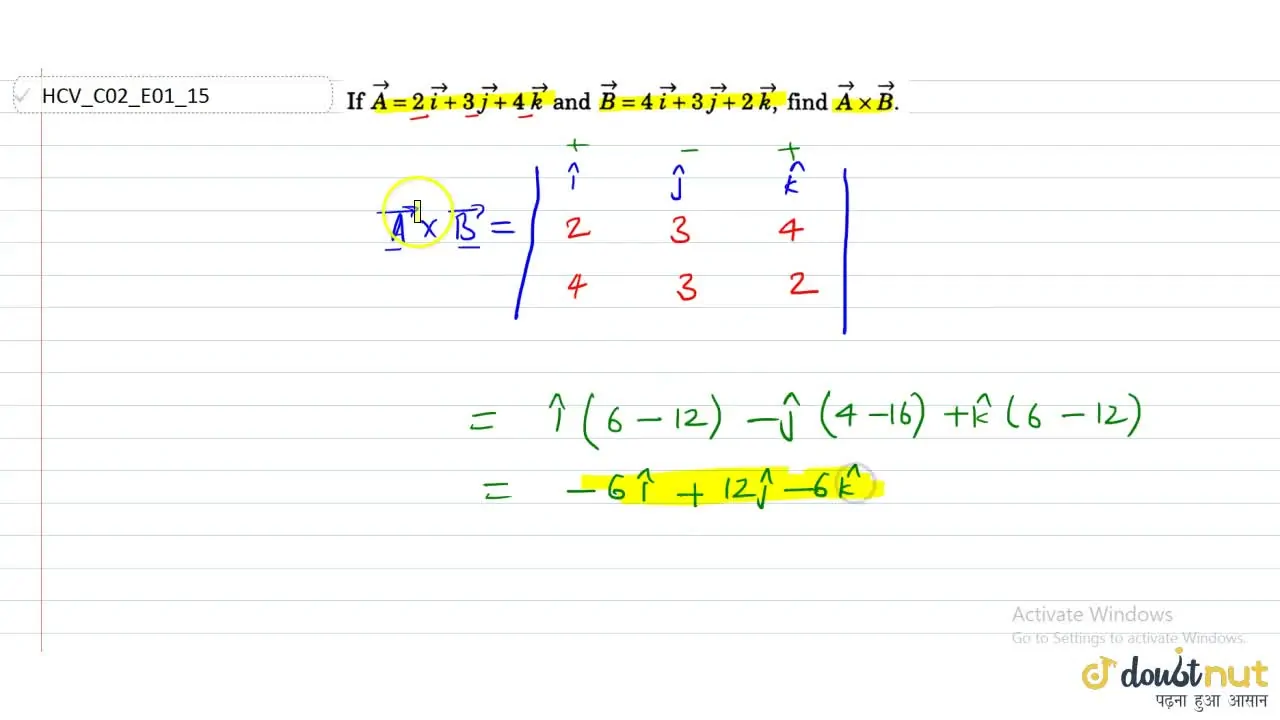If →A=2→i+3→j+4→kand→B=4→i+3→j+2→k,f∈d→A×→B.
The correct Answer is:−6ˆi+12ˆj−6ˆk
→A=2ˆi+3ˆj+4ˆk<br>→B=4ˆi+3ˆj+2ˆk,→A×→B=∣∣ ∣ ∣∣ˆiˆjˆk234432∣∣ ∣ ∣∣<br>ˆi(6−12)−ˆj(4−16)+ˆk(6−12)<br>=−6ˆi+12ˆj−6ˆk.
Related Playlists
- BOOK - HC VERMACHAPTER - PHYSICS AND MATHEMATICSEXERCISE - Objective 25videos
PHYSICS AND MATHEMATICS
- BOOK - HC VERMACHAPTER - NEWTON'S LAWS OF MOTIONEXERCISE - Exercises42videos
NEWTON'S LAWS OF MOTION
- BOOK - HC VERMACHAPTER - REST AND MOTION : KINEMATICSEXERCISE - Exercises51videos
REST AND MOTION : KINEMATICS
Similar Questions
If →a=2→i−3→j+2→k and →b=→i+2→j+→k, find (i)→a.→b, (ii)→a×→b and (iii)→b×→a
View SolutionIf →A=2→i+→j−3→k→B=→i−2→j+→kand→C=−→i+→j−→4k find →A×(→B×→C)
View SolutionIF →a=2→i+3→j+4→kand→b=4→i+3→j+2→k find the angle between →aand→b.
View SolutionIf →A=2→i−3→j+7→k,→B=→i+2→kand→C=→j−→k find →A.(→B×→C).
View SolutionIf →a=2→j+3→j−→k,→b=−→i+2→j−4→kand→c=→i+→j+→k, then find the value of (→a×→b).(→a×→c)
View SolutionIf →a=2→j+3→j−→k,→b=−→i+2→j−4→kand→c=→i+→j+→k, then find the value of (→a×→b).(→a×→c)
View SolutionIf →a=→i+→j+→k,
→b=4→i+3→j+4→kand→c=→i+α→j+β→k are lineerly independent vectors and |→c|=√3, thenView SolutionLet →a=2→i+3→j+4→kand→b=3→i+4→j+5→k. Find the angle between them.
View SolutionIf →a=2→i+3→j and →b=→i+→j, find (i)→a.→b, (ii)→a×→b and (iii)→b×→a
View SolutionExamine whether the vectors →a=2→i+3→j+2→k,→b=→i−→j+2→kand→c=3→i+2→j−4→k form a left handed or a righat handed system.
View Solution


